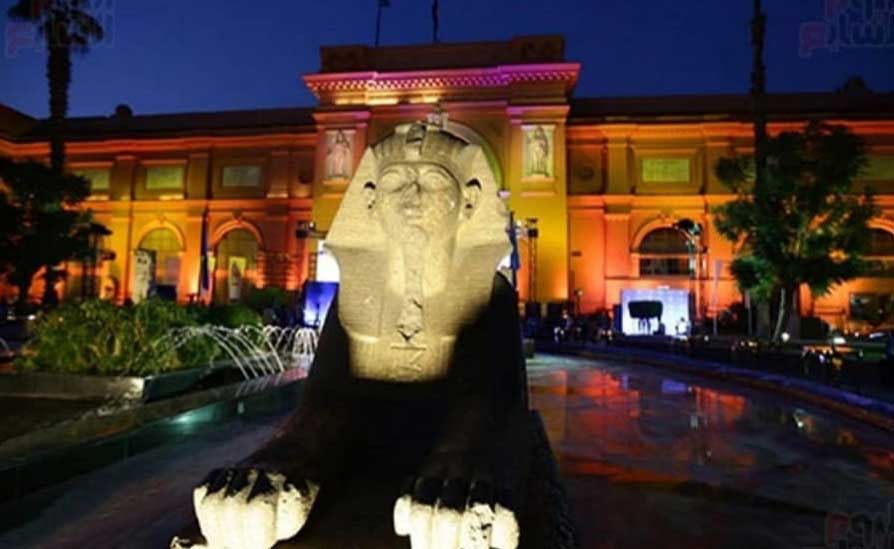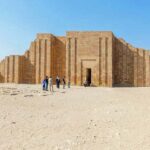The Egyptian Museum is the oldest archaeological museum in the Middle East, and houses the largest collection of Pharaonic antiquities in the world. The museum displays an extensive collection spanning from the Predynastic Period to the Greco-Roman Era.
This famous museum houses the world’s largest collection of ancient Egyption artifacts (more than 120,000 items on display) featuring the famous Tutankhamun collection with its beautiful gold death mask and sarcophagus and the royal Mummy room, which houses an additional eleven Pharaonic dignitaries.
This article contains information about The Museum of Egyptian Antiquities at Tahrr Square in Cairo including:
- Where is the Egyptian Museum located?
- The architect of The Egyptian Museum
- Visiting The Museum of Egyptian antiquities
- How much does it cost to visit The Egyptian Museum?
- The security at the Egyptian Museum
- The Items on display at the Museum of Egyptian antiquities
- Recommended Tours to The Egyptian Museum
Where is the Egyptian Museum located?
The Egyptian Museum address is: Tahrir Square at Downtown, Cairo. Egyptians refer to Downtown as Wust al-Balad, or in other words “The heart of the city”. The reason of calling it so is because the Downtown area is the part of the city that is full of life and activities. Cairo is sometimes called “the city that never sleeps” of Egypt, and so for Downtown. It is not only the heart of Cairo, but also the center for every life activity and facility, and the hub for different cultures. Downtown is famous for Midan Talaat Harb and Midan Tahrir.
The architect of the Egyptian Museum
The architect of the building was selected through an international competition in 1895, which was the first of its kind, and was won by the French architect, Marcel Dourgnon. The museum was inaugurated in 1902 by Khedive Abbas Helmy II, and has become a historic landmark in downtown Cairo, and home to some of the world’s most magnificent ancient masterpieces.
Visiting the Museum of Egyptian antiquities
Designed in the Neoclassical style by Marcel Dourgnon, the Egyptian Museum boasts 107 halls filled with artifacts dating from the prehistoric through the Roman periods, with the majority of the collection focused on the pharaonic era. The museum houses approximately 160,000 objects covering 5,000 years of Egypt’s past.
The ground floor takes the visitor on a chronological tour through the collections, while the objects on the upper floor are grouped according to tomb or category; exhibits here include the treasures of Tutankhamun, wooden models of daily life, statuettes of divinities, and a rare group of Faiyum Portraits. On display on the second floor are also many of the New Kingdom royal mummies.
Labels are in Arabic and English

How much does it cost to visit the Egyptian Museum in Cairo?
Tickets, which cost 200 Egyptian pounds (approximately $14) for adults and 100 Egyptian pounds (or $7) for students, can be purchased at the entrance’s visitors center.
The security at the Egyptian Museum
As for security issues, until the year 1996, the museum’s security was all about just locking the door at night. However, that wasn’t enough as thieves were managed to let themselves in. As a result, the museum’s authorities applied some alarms and detectors for security issues along with improving the lighting system for the whole museum. During the Egyptian revolution in 2011, the museum was attacked by thugs and some artifacts were stolen. At that time, civilians reacted quickly and courageously to prevent further theft. They formed a human chain around the building in Tahrir to secure it, and they managed to protect the museum.
The Items on display at the Museum of Egyptian antiquities
Centrally located on the edge of Tahrir Square in Cairo, the Egyptian Museum is hard to miss on any tour of Cairo. Opening in 1902, it was purpose-built to house the antiquities of Ancient Egypt. Inside is the greatest collection of Ancient Egyptian archeological history in the world.
Among the museum’s unrivaled collection are the complete burials of Yuya and Thuya, Psusennes I and the treasures of Tanis, and the Narmer Palette commemorating the unification of Upper and Lower Egypt under one king, which is also among the museum’s invaluable artifacts. The museum also houses the splendid statues of the great kings Khufu, Khafre, and Menkaure, the builders of the pyramids at the Giza plateau. An extensive collection of papyri, sarcophagi and jewelry, among other objects, completes this uniquely expansive museum.
The Egyptian museum in Cairo houses over 120,000 artifacts, including the contents of Tutankhamen’s tomb and most of the mummies that have been discovered since the 19th century. The museum’s exhibits span from the beginning of the Old Kingdom of Ancient Egypt (approximately 2700 BC) through the Greco-Roman period.The building consists of two floors. On the ground floor, you can follow the history of Egypt from the Old Kingdom up through the Greco-Roman period by turning left at the entrance and looping around the museum. This provides a good background for most of Egypt’s ancient history.
Upstairs the museum is organized thematically with a large portion of the area taken up the exhibit of the contents of Tutankhamun’s tomb, including his famous funerary mask. Also upstairs is the room dedicated to the beautiful jewelry discovered in the Royal Tombs of Tanis. Another highlight of the museum, the Royal Mummy Room, requires the purchase of a separate ticket. Inside you can see the mummies of some of Egypt’s most famous pharaohs, including Ramesses II, Seti I, and Egypt’s only queen, Hatshepsut.
The museum has so much to offer that it can be overwhelming. It suffers from the fact that much of the contents have not been relabeled or reorganized since they were first arranged in their cases over a century ago. The result is that some sections provide very little context for the artifacts and labels are shown in a variety of languages- French, English, Greek, German, and Arabic. The difficulty of navigating the exhibits is a common complaint by visitors and a good reason to have a guide with you.
The Egyptian museum, also known as the museum of ancient Egyptian civilization, houses some of the world’s most important collections of ancient artifacts. Inside the walls of that great and old pinkish building located in Downtown Maidan Al-Tahrir, the priceless treasures of King Tutankhamun and some other ancient Egyptian greatest pharaohs, along with the belongings, mummies, jewellery, and food bowls of Ancient Egyptians that were buried with the kings to use in the afterlife as believed by the ancient Egyptians.
More than 100,000 ancient Objects
The Egyptian museum in Cairo houses a great and enormous collection of artifacts, mummies, coffins, stones, ancient belongings, and even food types that used to be buried with the kings before death to use in the afterlife. As part of the ancient Egyptian beliefs and religion, ancient Egyptians used to bury the dead with all their belongings as they believed that they will use their clothes and food when they pass to the After Life.
As an interesting fact, Kings were buried with not only their material belongings, but also with their “servants”. The Museum’s collection is growing rapidly as archaeologists make new discoveries over time. For instance, Tutankhamun’s enormous tomb and the impressive discoveries that were made inside it, and the tomb belongings of Tanis which were both discovered after the museum opened. Now the museum has more than 100,000 ancient objects inside its walls. Some objects were moved to the new Grand Egyptian Museum, while most of them are still in the main museum in Tahrir. The museum in Tahrir will remain the major spot for the ancient Egyptian heritage, even after the opening of the Grand Museum. In 1835, Mohammed Ali, the ruler of Egypt at that time, completely banned the export of ancient antiquities in order to protect the country’s heritage.
The Displays of the Old Kingdom
The Old Kingdom in ancient Egyptian history, also known as the “Pyramids Builders Period”, was a very vital period that left us so many remarkable artifacts and objects, and that’s why it has a huge section in the museum. Some of the most important achievements of that period are the Pyramids of Giza, the Step Pyramid of Saqqara, the Pyramids of Dahshur, and the Pyramids of Abu Sir. As a part of the Old Kingdom, there is that statue of King Khafre which is made out of alabaster. It is put on display in the second half of the ground floor of the museum. The Museum Of Egyptian Antiquities also houses a huge collection of small statues of servants carrying out their everyday duties and responsibilities, as a representation of everyday life at that time.
The Displays of the Middle Kingdom:
The Museum houses ten of the most remarkable statues that date back to the Middle Kingdom. The ten statues portray King Senosert I, who belongs to the 12th dynasty and all of them are made out of limestone. The Middle Kingdom period started in Egypt after the fall of the Old Kingdom and it wasn’t really a great period of the ancient Egyptian history in every aspect. At the beginning of the 12th dynasty, the living conditions of the ancient Egyptians were significantly improved and even arts, industries, and artifacts witnessed a great improvement.
However, when the living conditions went bad, Egypt went through a transitional period once again, as the nobles fought among each other. Such corruption and chaos lead to the Hyksos invading the country. King Ahmose was able to defeat the Hyksos and bring back Egypt’s freedom. After that, Ahmose founded the 18th dynasty, which was the first dynasty of the New Kingdom.










